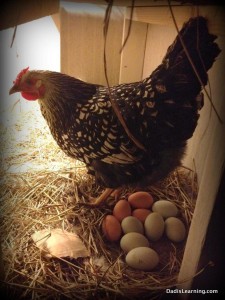Eggs Come From Where???
Last summer I was out collecting eggs with our oldest daughter and she asked me where eggs come from. I told her the basic version and she said, “Eggs come from where???”
I think one of the favorite lessons I have ever given was a personal reasoning of why I believe there must be a Creator for the world we live in. In the lesson I used our chickens and their eggs as one of my proofs of design. Eggs seem so simple, but they are amazingly complex!
Over the years of having backyard chickens I have learned a lot about these unique birds and the fascinating process of how they produce a sustainable food source. First off, you do not need a rooster to get an egg. Hens lay eggs with or without a rooster. A rooster only fertilizes the egg in a process that I won’t detail here.
Did you know that the egg laying process begins in the eye? Actually it begins just behind the eye in a photo-receptive gland called the pituitary gland. Light triggers the egg making process which takes approximately 25 hours for most hens. Hens are born with thousands of ova, or undeveloped egg yolks.
As hens mature to be about 20 weeks old the ova will start developing and releasing. Hens typically have several ova at various stages of development. The ovum (a mature ova or what we call the yolk) is released into the oviduct which is about 2 feet long. The uterus releases a viscous substance called albumen, better known as egg white, that surrounds the yolks. Finally a mixture of water, salt, and calcium forms on the outside of the albumen and hardens into a shell. Any pigments that might give the shell color are the very last thing added to the egg.
The egg has now reached the end of the two foot journey down the oviduct and is given its unique shape by the uterine wall. The chicken has only one opening that is commonly called the vent. From this opening comes urates (chicken pee), fecal matter and the egg. Gross! ACTUALLY this is another amazing part of the egg production process…keep reading.
Just inside the chicken, two paths converge. One path is the end of the egg production process and the other is the natural release of waste. When a hen lays an egg the cloaca swings down and actually turns inside out (like turning a rubber glove inside out) and releases the egg through the vent so it never comes into contact with urates or fecal matter. For an added layer of protection the egg has an antibacterial coating on it that is commonly referred to as the “bloom.” This coating protects the egg from any sort of contamination.
Grossed out? Hopefully not. The more I learn about these simple birds the more I come to understand how complex they really are. Which came first, the chicken or the egg? Obviously it was the chicken. There is simply no way such a complex system for reproduction could have happened without a Creator. All around us are evidences of a Creator if we are willing to see them.
Here are some other interesting facts about hens and eggs:
- Hens will not lay an egg in the dark. Once the egg laying cycle hits dusk, the hen will hold the egg until daylight.
- Not sure how old an egg is? Submerge it in water. Good eggs will sink and bad eggs will float. Discard floaters.
- Most chickens lay for 2-3 years and have a lifespan of 5-6 years.
- Egg production can be stimulated during the short days of winter with artificial light in the coop.
- The color of the shell is determined by the breed of the chicken, as is size, shape and frequency of laying.
- Ever noticed a small ‘disc’ on the yolk? That is the blastoderm. In a fertilized egg that would develop into a chick if the egg were brooded or placed in an incubator. Commercial eggs are never fertilized.
Tuesdays I typically talk about faith matters. Today’s post was a bit different but I believe there is a message of faith in this post. If your family enjoys learning, I am continuing my family worship guide series about the life of David >>> Week 29 – David Becomes King
You can also check out my backyard chickens live on cam at one of my other sites – www.LiveChickenCam.com. If you want to learn even more about egg production you might check out www.ChickScope.com.


We had many young people visit us “on the farm” when we lived in Fort Worth, and most of them found it an eye-opening experience, especially in the area of “Where does food come from?” They may have looked at their eggs & milk with a suspicious eye after that
Haha…you’re so right Sarah! I know you guys had a lot more ‘food sources’ than we do. It can be really eye opening to see where your food comes from. I love eggs more now than I ever have, perhaps because I understand how much work each egg is.
It is not true that chickens only lay in the daytime. When I was a boy we had a White Wyandotte hen that layed an egg every night in her sleep. I would find the egg busted in the morning under where she slept. I finally put a bale of hay under her to keep her eggs from breaking and it worked. Her eggs were always double yolked too.